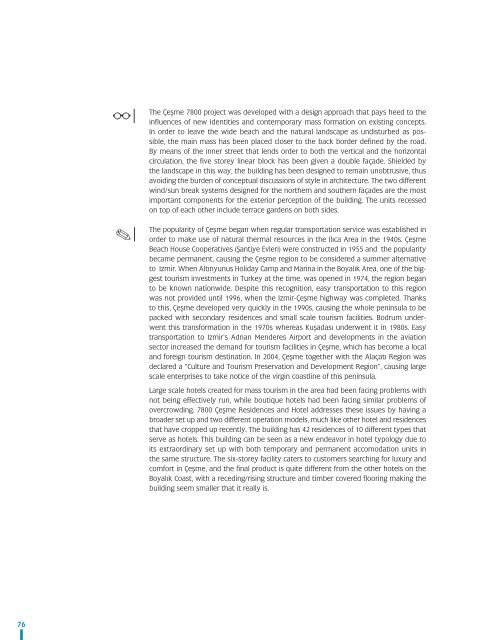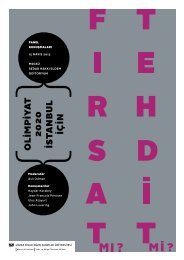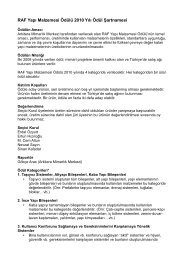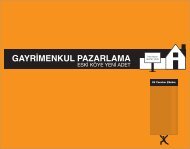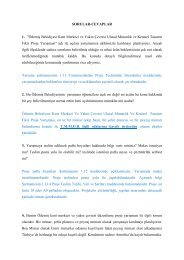VitrA ÃaÄdaÅ Mimarlık Dizisi - Arkitera
VitrA ÃaÄdaÅ Mimarlık Dizisi - Arkitera
VitrA ÃaÄdaÅ Mimarlık Dizisi - Arkitera
Create successful ePaper yourself
Turn your PDF publications into a flip-book with our unique Google optimized e-Paper software.
The Çeşme 7800 project was developed with a design approach that pays heed to the<br />
influences of new identities and contemporary mass formation on existing concepts.<br />
In order to leave the wide beach and the natural landscape as undisturbed as possible,<br />
the main mass has been placed closer to the back border defined by the road.<br />
By means of the inner street that lends order to both the vertical and the horizontal<br />
circulation, the five storey linear block has been given a double façade. Shielded by<br />
the landscape in this way, the building has been designed to remain unobtrusive, thus<br />
avoiding the burden of conceptual discussions of style in architecture. The two different<br />
wind/sun break systems designed for the northern and southern façades are the most<br />
important components for the exterior perception of the building. The units recessed<br />
on top of each other include terrace gardens on both sides.<br />
✎<br />
The popularity of Çeşme began when regular transportation service was established in<br />
order to make use of natural thermal resources in the Ilıca Area in the 1940s. Çeşme<br />
Beach House Cooperatives (Şantiye Evleri) were constructed in 1955 and the popularity<br />
became permanent, causing the Çeşme region to be considered a summer alternative<br />
to Izmir. When Altınyunus Holiday Camp and Marina in the Boyalık Area, one of the biggest<br />
tourism investments in Turkey at the time, was opened in 1974, the region began<br />
to be known nationwide. Despite this recognition, easy transportation to this region<br />
was not provided until 1996, when the Izmir-Çeşme highway was completed. Thanks<br />
to this, Çeşme developed very quickly in the 1990s, causing the whole peninsula to be<br />
packed with secondary residences and small scale tourism facilities. Bodrum underwent<br />
this transformation in the 1970s whereas Kuşadası underwent it in 1980s. Easy<br />
transportation to Izmir’s Adnan Menderes Airport and developments in the aviation<br />
sector increased the demand for tourism facilities in Çeşme, which has become a local<br />
and foreign tourism destination. In 2004, Çeşme together with the Alaçatı Region was<br />
declared a “Culture and Tourism Preservation and Development Region”, causing large<br />
scale enterprises to take notice of the virgin coastline of this peninsula.<br />
Large scale hotels created for mass tourism in the area had been facing problems with<br />
not being effectively run, while boutique hotels had been facing similar problems of<br />
overcrowding. 7800 Çeşme Residences and Hotel addresses these issues by having a<br />
broader set up and two different operation models, much like other hotel and residences<br />
that have cropped up recently. The building has 42 residences of 10 different types that<br />
serve as hotels. This building can be seen as a new endeavor in hotel typology due to<br />
its extraordinary set up with both temporary and permanent accomodation units in<br />
the same structure. The six-storey facility caters to customers searching for luxury and<br />
comfort in Çeşme, and the final product is quite different from the other hotels on the<br />
Boyalık Coast, with a receding/rising structure and timber covered flooring making the<br />
building seem smaller that it really is.<br />
76


